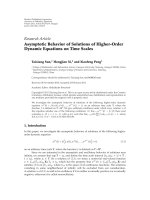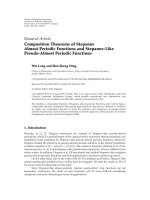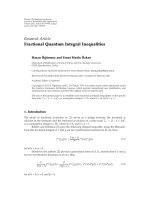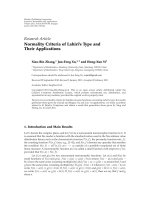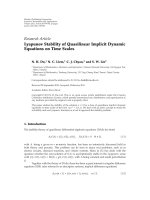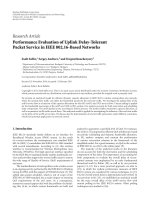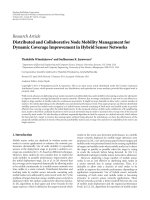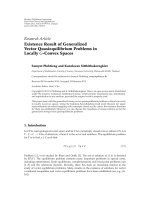Báo cáo hóa học: " Research Article Hybrid Modeling of Intra-DCT Coefficients for Real-Time Video Encoding" potx
Bạn đang xem bản rút gọn của tài liệu. Xem và tải ngay bản đầy đủ của tài liệu tại đây (430.07 KB, 3 trang )
Hindawi Publishing Corporation
EURASIP Journal on Image and Video Processing
Volume 2008, Article ID 676094, 3 pages
doi:10.1155/2008/676094
Editorial
Anthropocentric Video Analysis: Tools and Applications
Nikos Nikolaidis,
1, 2
Maja Pantic,
3, 4
and Ioannis Pitas
1, 2
1
Department of Informat ics, Aristotle University of Thessaloniki, 54124 Thessaloniki, Greece
2
Informatics and Telematics Institute, CERTH, 57001 Thermi-Thessaloniki, Greece
3
Department of Computing, Imperial College London, London SW7 2AZ, UK
4
Department of Computer Science, University of Twente, 7522 NB Enschede, The Netherlands
Correspondence should be addressed to Nikos Nikolaidis,
Received 23 April 2008; Accepted 23 April 2008
Copyright © 2008 Nikos Nikolaidis et al. This is an open access article distributed under the Creative Commons Attribution
License, which permits unrestricted use, distribution, and reproduction in any medium, provided the original work is properly
cited.
During the last two decades, we have witnessed an increasing
research interest towards what one could call anthropocentric
video analysis, namely, algorithms that aim to extract,
describe, and organize information regarding the basic
element of most videos: humans. This diverse group of
algorithms processes videos from various sources (movies,
home videos, T V programmes, surveillance videos, etc.) and
extracts a wealth of useful information. A large cluster of
algorithms target information related to the state or state
transitions of individuals: presence and position/posture
through face or body detection, body or body parts tracking
and posture estimation; identity by means of face recogni-
tion/verification, full-body recognition, gait analysis, and so
forth; emotional state through facial expression, body ges-
ture, and/or posture analysis; performed actions or activities;
and behavior through spatio-temporal analysis of various
behavioral cues including facial/head/hand/body gestures
and postures. Another smaller group of techniques focuses
on detecting or recognizing interactions or communication
modes by means of visual speech recognition, dialogue
detection, social signals recognition such as head nods
and gaze exchanges, recognition of activities or events in
multiple-person environments (e.g., event analysis in sport
videos or crowd-scene analysis, etc.). Finally, a number of
techniques aim at deriving information regarding physical
characteristics of humans, mainly in the form of 3D head or
full-body models.
The interest of the scientific community for anthro-
pocentric video analysis stems from the fact that the
extracted information can be utilised in various important
applications. First of all, it can be used to devise intuitive
and natural paradigms of man-machine interaction, for
example, through gesture-based interfaces, visual (or audio-
visual) speech recognition, interfaces that understand and
adapt to the emotional state of users, and interfaces between
virtual characters a nd human users, which are governed by
the same social rules as the human-human interaction. In
the same wavelength, but in a considerably broader scope,
anthropocentric video analysis techniques are some of the
enabling technologies for the so-called ubiquitous comput-
ing trend ( also known as pervasive computing or ambient
intelligence) where a large number of small (or embedded),
interconnected, and clever computing devices and sensors
cooperate to assist people in their everyday life in an
unobtrusive and natural way. An intelligent living space, that
controls lighting, music, temperature, and home appliances
according to the inhabitants’ mood, location, habits, and
behavioral patterns indicating their intention, is frequently
used as an example of this trend. Moreover, techniques
like person detection, tracking, recognition or verification,
and activ ity recognition are already being integrated in
smart surveillance systems, access-control systems, and other
security systems capable of detecting access permission
violations, abnormal behaviors, or potentially dangerous
situations. In addition, data derived from anthropocentric
video analysis techniques can be used to infer human-related
semantic information for videos, to be utilised in video
annotation, retrieval, indexing, browsing, summarisation,
genre classification, and similar tasks. Highlights detection
in sport videos, automatic generation of visual movie
summaries, and content-based retrieval in video databases
are only some of the applications in this category that can
benefit from human-centric analysis of video. Finally, such
algorithms are indispensable building blocks for a number
2 EURASIP Journal on Image and Video Processing
of other applications that include automatic diagnosis of
neuromuscular and orthopaedic disorders, performance
analysis of athletes, intelligent/immersive videoconferencing,
automated creation of 3D models for animated mov ies,
users’ avatar animation in virtual environments and games,
and so forth.
The papers that have been selected for publication
in this special issue present interesting new ideas in a
number of anthropocentric video analysis topics. Although
not all areas mentioned above are represented, we do hope
that the issue will give readers the opportunity to sample
some state-of-the-art approaches and appreciate the diverse
methodologies, research directions, and challenges in this
hot and extremely broad field.
Most papers in this issue address either the problem of
person detection and tracking or the problem of human body
posture estimation.
In “Detection and tracking of humans and faces,” by S.
Karlsson et al., a framework for multi-object detection and
tracking is proposed, and its performance is demonstrated
on videos of people and faces. The proposed framework
integrates a prior knowledge of object categories (in the form
of a trained object detector) with a probabilistic tracking
scheme. The authors experimentally show that the proposed
integration of detection and tracking steps improves the state
estimation of the tracked targets.
In “Integrated detection, tr a cking, and recognition of
faces with omni video ar ray in intelligent environments,”
by K. S. Huang and M. Trivedi, robust algorithms are
proposed for face detection, tracking, and recognition in
videos obtained by an omnidirectional camera. Skin tone
detection and face contour ellipse detection are used for the
face detection, a view-based face classification is applied to
reject the nonface candidates, and Kalman filtering is applied
for face tr acking. For face recognition, the best results have
been obtained by a continuous hidden Markov model-based
method, where accumulation of matching scores along the
video boosts the accuracy of face recognition.
In “Monocular 3D tracking of articulated human motion
in silhouette and pose manifolds,” F. Guo and G. Qian
propose a system that is capable of t racking the human body
in 3D from a single camera. The authors construct low-
dimensional human body silhouette and pose manifolds,
establish appropriate mappings between these two manifolds
through training, and perform particle filter tracking over
the pose manifold.
The paper “Multi-view-based cooperative tracking of
multiple human objects” by C L. Huang and K C. Lien
presents a multiple person tracking approach that utilises
information from multiple cameras in order to achieve
efficient occlusion handling. The idea is that the tracking of
a certain target in a view where this target is fully visible
can assist the tracking of the same target in a view where
occlusion occurs. Particle filters are employed for tracking,
whereas two hidden Markov processes are employed to
represent the tracking and occlusion status of each target in
each view.
The paper “3D shape-encoded particle filter for object
tracking and its application to human body tracking” by
H. Moon and R. Chellappa proposes a method for tracking
and estimating objec t motion by using particle propagation
and the 3D model of the object. The measurement update
is carried out by particle branching according to weights
computed by shape-encoded filtering. This shape filter has
the overall form of the predicted projection of the 3D model,
where the 3D model is designed to emphasise the changes in
2D object shape due to motion. Time update is handled by
minimising the prediction error and by adaptively adjusting
the amount of random diffusion. The authors experimentally
show that the method is able to effectively and efficiently
track walking humans in real-life videos.
In their paper entitled “Human posture tracking and
classification through stereo vision and 3D model matching,”
S. Pellegrini and L. Iochhi present a method for human body
posture recognition and classification from data acquired
from a stereo camera. A tracking algorithm operating on
these data provides 3D information regarding the tracked
body. The proposed method uses a variant of ICP to
fit a simplified 3D human body model and then tracks
characteristic points on this model using Kalman filtering.
Subsequently, body postures are classified through a hidden
Markov model to a limited number of basic postures.
The seventh paper, “Compression of human motion
animation using the reduction of inter-joint correlation” by
S. Li et al. is closely related to the papers outlined above since
it deals with the important issue of compressing human body
motion data derived either through video-based motion
tracking or motion capture equipment (e.g., magnetic
trackers). Two different approaches for the compression
of such data, represented as joint angles in a hierarchical
structure, are proposed. The first method combines the
wavelet transform with forward kinematics and allows for
progressive decoding. The second method, which provides
better results, is based on prediction and inverse kinematics.
Thefollowingtwopapersdealwithhumanactivity
recognition. An algorithm based on motion and color infor-
mation, is presented by A. Briassouli et al. in “Combination
of accumulated motion and color segmentation for human
activity analysis.” The algorithm accumulates optical flow
estimates and processes their higher-order statistics in order
to extract areas of activity. MPEG-7 descriptors extracted
for the activ ity area contours are used for comparing sub-
sequences and detecting or analysing the depic ted actions.
This information is complemented by mean shift colour
segmentation of the moving and static areas of the video,
that provides information about the scene where the activity
occurs and also leads to accurate object segmentation.
The paper “Activity representation using 3D shape
models,” by M. Abdelkader et al., presents a method for
human activity representation and recognition that is based
on 3D shapes generated by the target activity. Motion
trajectories of points extracted from objects (e.g., human
body parts) involved in the activity are used to build these 3D
shape models for each activity, which are subsequently used
for classification and detection of either target or unusual
activities.
Finally, each of the last two papers in this special issue
deal with a different problem. The paper “Comparison of
Nikos Nikolaidis et al. 3
image transform based features for visual speech recognition
in clean and corrupted video” authored by R. Seymour et al.
deals with the important problem of visual speech recog-
nition. More specifically, the paper studies and compares
theperformanceofanumberoftransform-basedfeatures
(including novel features extracted using the discrete curvelet
transform) as well as feature set selection methods for visual
speech recognition of isolated digits. Both clean video data
and data corrupted by compression, blurring and jitter are
used to assess the features’ robustness to noise.
On the other hand, the paper “Athropocentric video
segmentation for lecture webcasts” by G. Friedland and
R. Rojas describes an interesting application of person
detection and segmentation. The challenge addressed is that
of recording and transmission of lectures in high quality
and in a bandwidth-efficient way. An electronic whiteboard
is used to record in vector format the handw ritten content
of the board whereas the lecturer is segmented in real time
from the background by constructing, through a clustering
approach, a colour signature for the background and by
suppressing the changes introduced to the background due
to the lecturer’s handwriting. The segmented lecturer is then
pasted semitransparently on the whiteboard content, and the
synthesised sequence is played back or transmitted as MPEG-
4video.
ACKNOWLEDGMENTS
The guest editors of this issue wish to thank the reviewers
who have volunteered their time to provide valuable feedback
to the authors. They would also like to express their gratitude
to the contributors for making this issue an important asset
to the existing body of literature in the field. Many thanks to
the editorial support of the EURASIP Journal on Image and
Video Processing for their help during the preparation of this
issue.
Nikos Nikolaidis,
Maja P antic
Ioannis P itas
